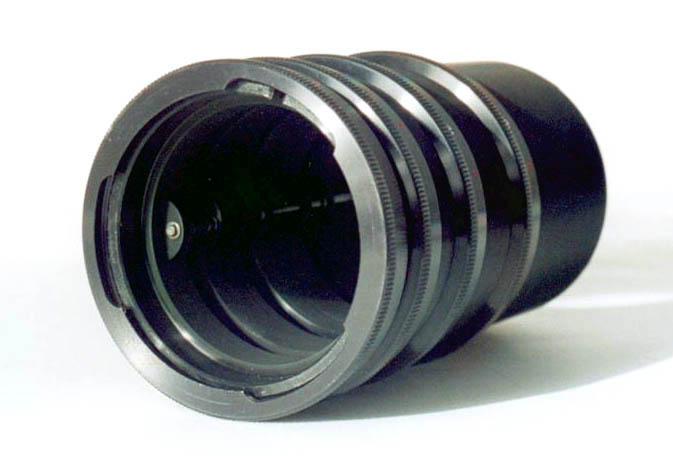
[C309-13: Pentacon Six automatic extension tubes.
The pin that operates the lens diaphragm can be seen inside the tubes.]
Close up tubes
Close-up (or extension) tubes made by Pentacon, Exakta and Arsenal are available.

[C309-13: Pentacon Six automatic extension tubes.
The pin that operates the lens diaphragm can be seen inside the tubes.]
Pentacon
This manufacturer made two types of extension tubes over many years:
Manual
and automatic tubes.
Manual tubes
The manual tubes lack the aperture pin that holds the lens diaphragm
open until the shutter is fired. To see charts showing the image
area covered, image scale, etc., click here.
Diaphragm automation may be obtained by adding the special Pentacon aperture control ring with a double cable release – see the pages on the Pentacon Six bellows.
Automatic tubes
Pentacon’s standard automatic extension tubes come as a set of four.
In the image at the top of this page it should be possible to see the aperture
control pin. Using any one of the tubes, or any combination of them,
provides an enormous range of magnification, and Pentacon published lists
of the image area covered by each tube or combination of tubes, and the
exposure factors necessary to correct for a meter reading taken without
the tubes. Using a TTL meter avoids the need to use these correction
factors, and is the approach I always use. To see the charts showing
the image area covered, image scale, etc., click here.
Pentacon realised that there was a gap in the range between using the standard Biometar 80mm lens on its own at maximum extension, and using the same lens at minimum extension (i.e., infinity focus) with the shortest tube in the set. They therefore made a further tube to cover that gap. This tube gives an extension of 10mm, and it is so shallow that there is no space for the standard breech-lock ring; instead, the tube is mounted first on the lens, by twisting it into place, and the lens/tube combination is then mounted on the camera body in the standard way.
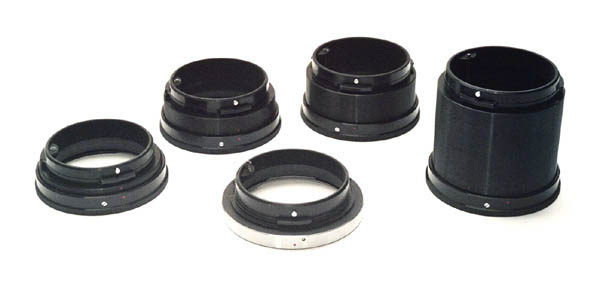
[C309-14: The Pentacon automatic extension tube set at the back, with
the special 10mm tube in front of them.]
Note: older versions of the Pentacon tubes are chrome on the outside; all tubes are matt black inside.
Arsenal
A two-tube set made by Arsenal is available. A few years ago
these were supplied as a standard accessory with the Kiev 60, but now they
are not usually included in the camera kit, and have to be purchased separately.
While being entirely adequate for the task, their design is not up to the
standard of the Pentacon tubes, and the maximum degree of extension available
is much shorter.
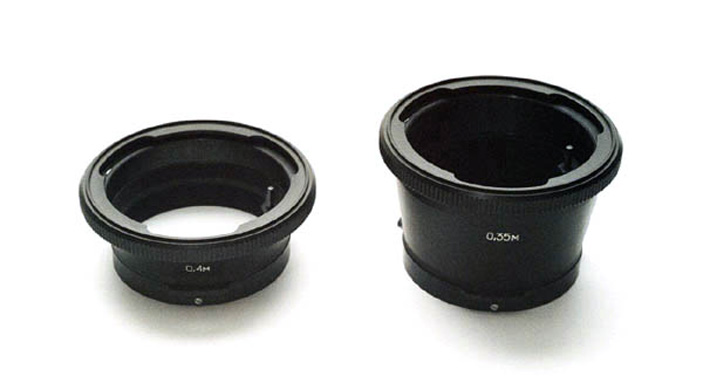
[C309-15: The Arsenal tubes. The numbers on the front of this
set of tubes apparently indicate
the minimum focussing distance when used individually with the standard
Arsenal lens.
The tubes can of course be used together.]
Manufacturing tolerances again come into play, and when I mount the Arsenal tubes on my Pentacon Six it is not possible to rotate the locking ring on the camera body by far enough for me to feel confident that the combination will not come apart (!). They work fine on the Kiev 60.
For the use of close-up tubes on the Kiev 88-6 body, follow this link.
Exakta
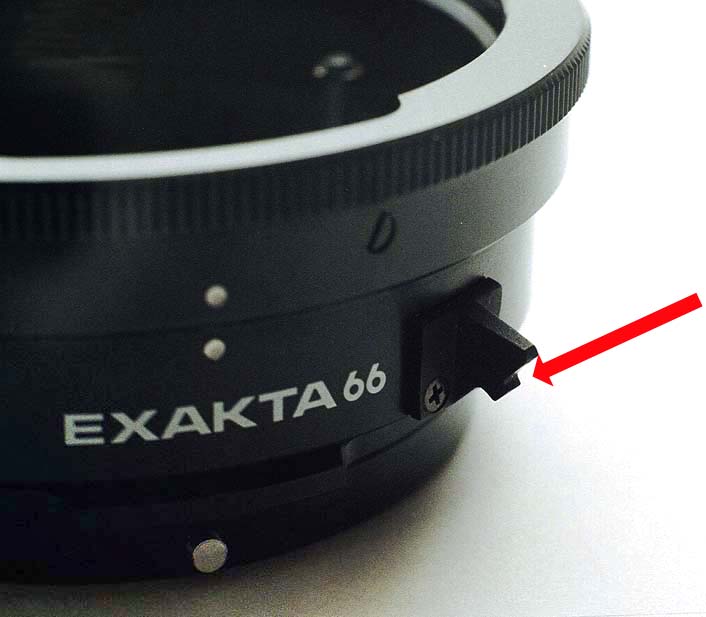
|
There is a set of four extension tubes for the Exakta 66. They
have the same dimensions as the Pentacon Six tubes and in fact look as
though they originated in the same factory. There are just two differences:
I need to investigate further the operation of stop-down metering on the Exakta 66, and plan to report on this website when I know the answers. |
Reversing tubes
Lenses are designed for optimum performance within a certain focussing
range. Generally, this range extends from infinity to the closest
point achieved with the focussing ring of the lens – although it is well
known for zoom lenses, in particular, to exhibit optical faults at certain
focal lengths. Fortunately, this is not a problem with the Carl Zeiss
Jena and Pentacon lenses.
However, beyond the closest focussing distance, greater definition may be achieved by reversing the lens – after all, the rear of the lens operates best over a range of a few inches (from the focal point of the lens to the film plane).
Pentacon manufactured a reversing tube. At one end this has a standard lens mount, so that it can be inserted into the front of the bellows, the front of an extension tube, or even directly into the body – although this gives very little control over the degree of magnification available.
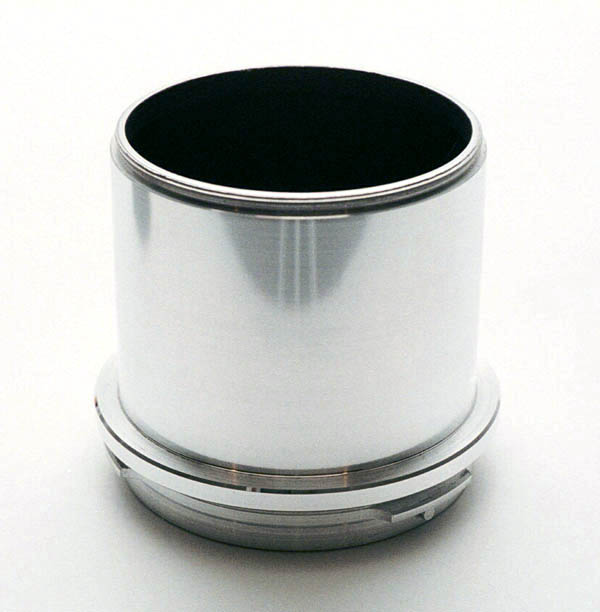
[C311-23: The Pentacon Reversing Tube]
The other end of the tube has a 58mm diameter thread, which screws straight
into the front of the standard 80mm f/2.8 Biometar lens. Obviously,
with adapter rings, other lenses could be used if required.
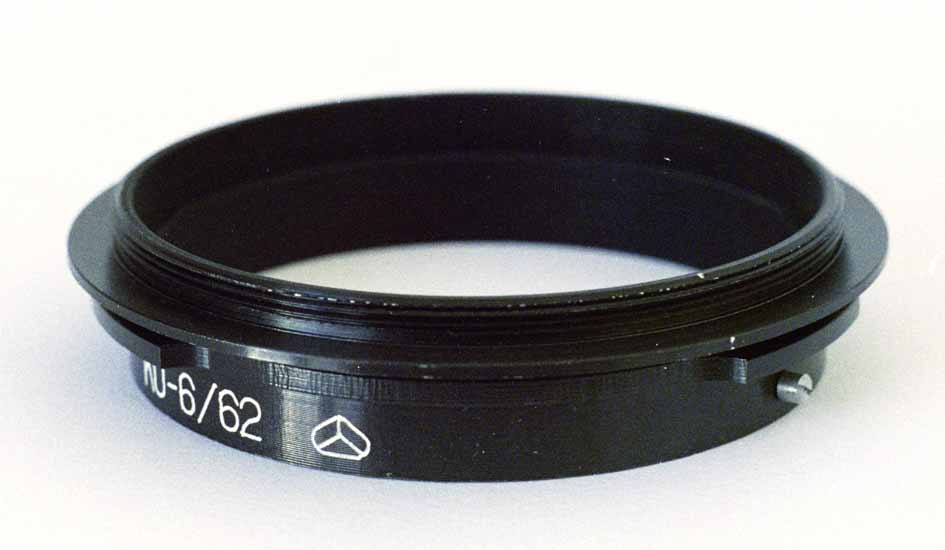
|
Arsenal also make a reversing ring for use with their system.
As can be seen from the illustration, it is a very slim affair, with the
Pentacon Six bayonet lens mount at one end, and a screw thread to take
their standard 80mm Volna lens at the other. This has a 62mm thread.
Incidentally, the Arsenal logo is clearly visible on this accessory. |
Special aperture control ring
The aperture control ring is described in detail in the section on
the Pentacon Six bellows.
Shading the lens when it is mounted
in reverse
The section on the Pentacon Six bellows explains how increased definition
may be obtainable when mounting the lens in reverse, via the reversing
tube. The rear element of the lens is then unprotected from stray
light that might degrade the image, or objects that might damage the lens.
An excellent lens shade for the rear of the lens can be provided by an
extension tube of suitable length. As the special aperture control
ring is quite shallow, consider adding a further tube if necessary to shade
the lens (checking carefully that no image cut-off is caused!).
Using tubes with lenses of various
focal lengths
Perhaps the assumption is that tubes are designed for use with the
standard lens only, and this is definitely the most-used lens for many
close-ups. However, consider two other options:

[C300-2: Kiev 60 with Carl Zeiss Jena 80mm Biometar “II”, Arsenal 2×
converter and Pentacon No 3 tube.
1/60 sec f/4, handheld. Notice the shallow depth of field.]
To go on to the next section, click below.
Next section (Mirror Pre-Release)
To go back to the beginning of the Accessories section, click below
and then choose the accessory that you want to read about.
Back to beginning of the Accessories section
© TRA February 2002, January 2009